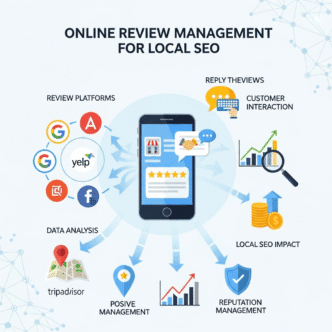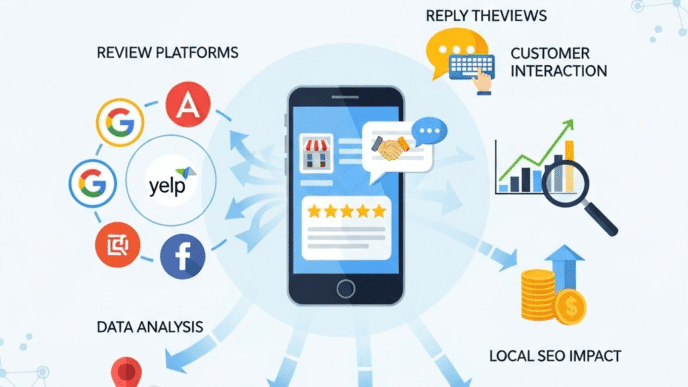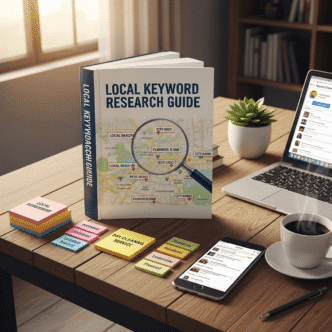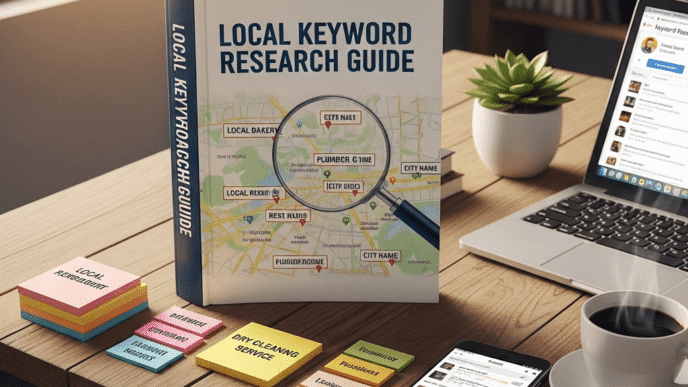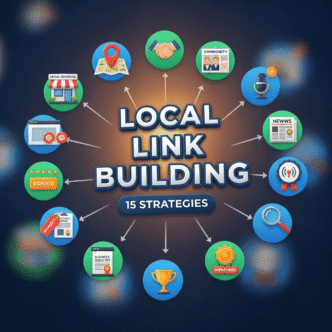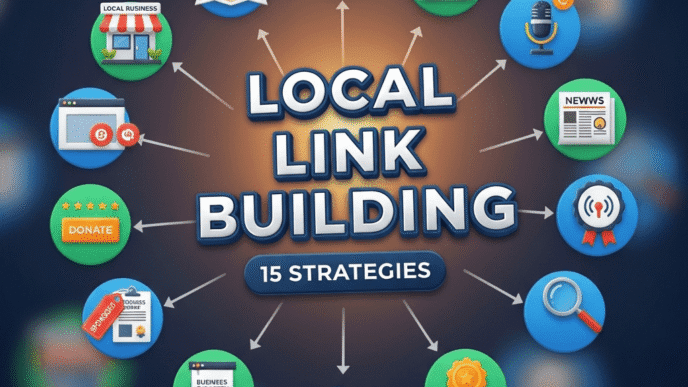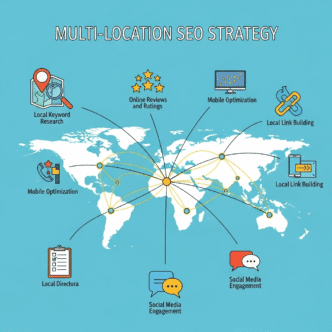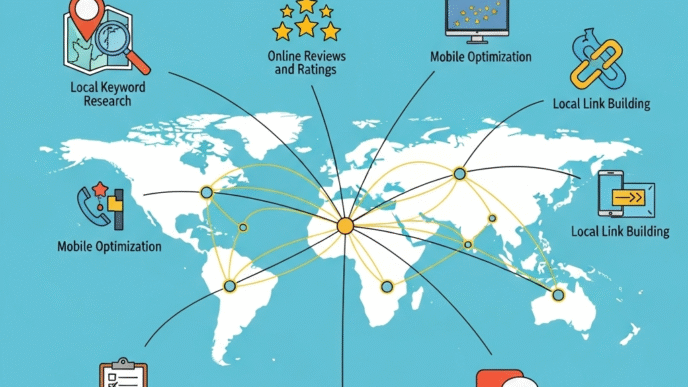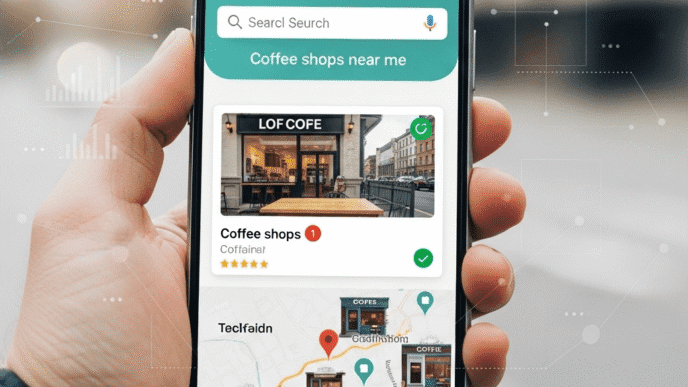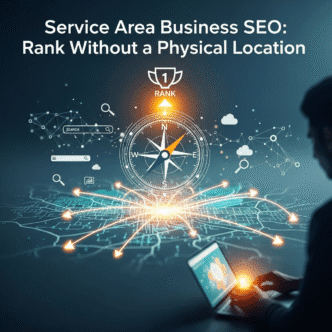Ever wonder why your competitor shows up in local search results while you’re stuck on page 3, even though you have a nicer website, better reviews, and offer the same services?
Here’s what nobody tells you: They probably have 147 citations scattered across the web, all saying the exact same thing about their business. You? You’ve got 12 citations, and half of them list your old address from three years ago when you were still operating out of your garage.
Local citation building is the unglamorous, tedious foundation of local SEO that most business owners ignore because it’s boring. And that’s exactly why it works so well for the businesses that actually do it. Citations account for 11% of local pack ranking factors and 7% of organic local ranking factors according to Whitespark’s research—which might not sound huge until you realize that’s often the difference between ranking #1 and #4 in your market.
In 2025, NAP consistency (Name, Address, Phone) across the web isn’t just important—it’s the trust signal that tells Google your business is legitimate, established, and worth showing to searchers. Inconsistencies confuse Google, dilute your authority, and make you look unprofessional to potential customers who can’t figure out which phone number actually reaches you.
This guide will show you exactly how to build local citations for SEO that actually move the needle, where to submit them, how to maintain consistency across hundreds of listings, and how to audit and fix the citation mess you probably don’t even know exists.
Let’s turn citation building from a confusing chore into a systematic competitive advantage.
Table of Contents
ToggleWhat Are Local Citations and Why Do They Matter?
Local citations are any online mention of your business’s name, address, and phone number. Think of them as digital references that confirm your business exists at a specific location.
A citation can be as simple as your business listed in a directory like Yelp, or as complex as a full profile with photos, reviews, and detailed information on a specialized industry platform.
What’s the Difference Between Structured and Unstructured Citations?
Structured citations appear in business directories and listings where information is organized in specific fields:
- Yelp
- Yellow Pages
- Better Business Bureau
- Facebook Business Page
- Industry-specific directories
These are the citations most people think of, and they’re the easiest to build and manage.
Unstructured citations are mentions of your NAP information in the wild—embedded in blog posts, news articles, event calendars, or sponsorship pages:
- Local news article mentioning your business
- Chamber of Commerce event page listing sponsors
- Blog post reviewing local businesses
- Government website listing licensed contractors
Both types matter, but structured citations are what you’ll focus on initially because they’re scalable and manageable.
How Do Citations Impact Your Local SEO Rankings?
Citations serve three critical functions that directly impact your visibility in local search:
Function #1: Validation Citations confirm to Google that your business is real, legitimate, and operates at the address you claim. The more consistent citations you have across trusted sources, the more confidence Google has in your information.
Function #2: Relevance Citations help Google understand what your business does and where you serve customers. When 50 directories consistently list you as “Johnson’s Plumbing – Chicago,” Google gains confidence that you’re relevant for plumbing searches in Chicago.
Function #3: Prominence The quantity and quality of your citations signal how established and well-known your business is. A business with 200 citations from authoritative sources appears more prominent than one with 10 citations from obscure directories.
According to Moz’s Local Search Ranking Factors research, citation signals contribute significantly to both local pack rankings and organic local rankings. For a complete understanding of how citations fit into your overall local strategy, check out our local SEO mastery guide.
“Citations are like votes of confidence from the internet. Each consistent citation tells Google ‘Yes, this business exists here and does this.’ The more votes you have, the more Google trusts you.” — Darren Shaw, Founder of Whitespark
What Is NAP Consistency and Why Is It Critical?
NAP consistency means your business Name, Address, and Phone number are identical across every single place they appear online. Not similar. Not close enough. Identical.
This sounds simple, but it’s where 80% of businesses screw up their local SEO without even realizing it.
What Counts as NAP Inconsistency?
Let me show you how easy it is to accidentally create inconsistencies:
Business Name Variations:
- “Johnson’s Plumbing”
- “Johnson’s Plumbing LLC”
- “Johnson’s Plumbing Services”
- “Johnsons Plumbing” (missing apostrophe)
- “Johnson Plumbing” (missing possessive entirely)
Google sees these as five different businesses, or at minimum, gets confused about which is correct.
Address Variations:
- “123 Main Street”
- “123 Main St”
- “123 Main St.”
- “123 Main Street, Suite 200”
- “123 Main St Ste 200”
- “123 Main St, #200”
Even tiny differences like “Street” vs “St” or “Suite” vs “Ste” create inconsistencies.
Phone Number Variations:
- (555) 123-4567
- 555-123-4567
- 555.123.4567
- 5551234567
- +1-555-123-4567
Same number, five different formats, and Google has to work harder to figure out they’re all you.
How Does NAP Inconsistency Hurt Your Rankings?
Diluted authority: If Google finds 30 citations with slight variations of your business name, it might split your authority across all those variations instead of consolidating it.
Confused algorithms: Google’s algorithms try to match citations to your Google Business Profile. When they can’t confidently match because of inconsistencies, you lose the ranking boost those citations should provide.
Lost trust signals: Inconsistencies make you look unprofessional or unstable. Did you move? Change your name? Are you even the same business?
Customer frustration: When potential customers find three different phone numbers for your business, they don’t know which one to call—so they call your competitor instead.
Real-World Example:
Marcus runs a law firm in Austin. When he hired a local SEO consultant, they discovered his NAP appeared in 73 different variations across 200+ listings:
- “Marcus Johnson Law” vs “Marcus Johnson Law Firm” vs “Marcus Johnson Attorney at Law”
- “Suite 305” vs “Ste 305” vs “#305” vs “Suite 305” (some with periods, some without)
- His old address from 4 years ago still appeared on 40 websites
The consultant spent 8 weeks cleaning up these inconsistencies. Within 90 days of achieving NAP consistency importance for local SEO, Marcus’s firm moved from ranking #7 to #2 in the local pack for “personal injury lawyer Austin,” and consultation requests increased 140%.
Where Should You Build Local Citations for Maximum Impact?
Not all citation sources are created equal. Building citations on high-authority, relevant platforms moves the needle. Building citations on spammy, irrelevant directories wastes your time.
What Are the Essential Citation Sources for Every Business?
These are the best citation sources for local businesses that every business should have, regardless of industry:
Tier 1: Major Data Aggregators (Do These First)
- Google Business Profile
- Facebook Business Page
- Apple Maps (via Apple Business Connect)
- Bing Places for Business
These four feed information to hundreds of other directories, so getting them right has a multiplier effect.
Tier 2: High-Authority General Directories
- Yelp
- Yellow Pages (yp.com)
- Better Business Bureau
- Foursquare
- MapQuest
- Yahoo Local
- Angie’s List (now Angi)
- Superpages
These are universally authoritative and relevant for virtually every business type.
Tier 3: Local Business Directories
- Local Chamber of Commerce
- City/County business directories
- State business registries
- Local news website business directories
- Community-specific directories
These provide local relevance signals that complement the major directories.
What Industry-Specific Citation Sources Should You Target?
Beyond general directories, target platforms specific to your industry. Here’s a breakdown:
| Industry | Top Industry-Specific Citations |
|---|---|
| Restaurants | TripAdvisor, OpenTable, Zomato, MenuPages, Zagat, Grubhub, DoorDash, Uber Eats |
| Healthcare | Healthgrades, Vitals, WebMD, Zocdoc, RateMDs, Wellness.com |
| Legal | Avvo, Justia, FindLaw, Lawyers.com, Martindale-Hubbell, Super Lawyers |
| Home Services | HomeAdvisor, Thumbtack, Porch, Houzz (for contractors), Angi, TaskRabbit |
| Automotive | Cars.com, Edmunds, CarGurus, RepairPal, Carfax, AutoMD |
| Hotels | TripAdvisor, Expedia, Hotels.com, Booking.com, Trivago |
| Real Estate | Zillow, Trulia, Realtor.com, Redfin |
| Retail | Google Shopping, Facebook Marketplace, Yelp, Merchant Circle |
Pro Tip: Focus on the 3-5 industry directories that customers in your niche actually use to find businesses. A citation on a directory nobody visits is worth less than a citation on a platform your customers actively search.
How Do You Find More Citation Opportunities?
Method 1: Competitor Citation Analysis
Research where your competitors are listed:
- Google your top 3 competitors
- Use tools like Moz Local, BrightLocal, or Whitespark to see their citation profiles
- Note directories where they appear but you don’t
- Create accounts on those relevant directories
Method 2: Google Search Operators
Search for directories in your niche:
- “submit business” + [your industry]
- “business directory” + [your city]
- [your industry] + “directory”
- “best [your industry] in [your city]”
Review the top results for submission opportunities.
Method 3: Local News and Community Sites
Many local news websites have business directories. Search:
- [your city] + “business directory”
- [your city] + “local business listings”
- [your city] + chamber of commerce
Method 4: Government and Association Sites
Check for:
- State licensing boards (if your industry requires licenses)
- Professional associations in your field
- Local government business registries
- Economic development organizations
How Do You Build Citations Step by Step?
Ready to start building? Here’s your complete local citation building strategy step by step.
Step 1: Standardize Your NAP Information
Before submitting to any directory, decide on your exact NAP format and document it.
Create a master NAP document with:
- Business name (exact legal name)
- Street address (choose abbreviation style: “Street” vs “St”)
- Suite/unit format (if applicable: “Suite” vs “Ste” vs “#”)
- City, State ZIP
- Phone number format (choose one: (555) 123-4567 vs 555-123-4567)
- Website URL (with or without www)
- Business description (200-word version)
- Business categories/keywords
- Hours of operation
- Social media profiles
Save this document and use it as your single source of truth for every citation submission.
Step 2: Claim and Optimize Major Platforms First
Start with the big four data aggregators because they feed hundreds of smaller directories:
Google Business Profile: Claim, verify, and optimize completely. This is your foundation. If you haven’t done this properly, check out our guide on Google Business Profile optimization.
Facebook Business Page: Create a complete business page with all information matching your master NAP exactly.
Apple Maps: Submit through Apple Business Connect (formerly Apple Business Register).
Bing Places: Claim and optimize your Bing Places for Business listing.
Step 3: Submit to High-Authority General Directories
Work through tier 2 directories systematically:
For each directory:
- Check if your business already exists (search by name, phone, address)
- If it exists, claim it
- If it doesn’t exist, create a new listing
- Fill out every available field
- Use your standardized NAP exactly as documented
- Add your logo and at least 3 photos
- Write a unique description (don’t just copy-paste everywhere)
- Add your business categories
- Save your login credentials (you’ll need them for updates)
Pro Tip: Use a password manager like LastPass or 1Password to store login credentials for every directory. You’ll need to access these accounts for updates, and trying to remember 50 different logins is a nightmare.
Step 4: Target Industry-Specific Directories
Submit to the 5-10 most relevant industry directories for your business type.
Research which directories your customers actually use. A citation on a directory with high domain authority but zero actual users in your industry is worth less than a citation on a niche directory where your customers actively search.
Step 5: Build Local Citations
Don’t overlook local opportunities:
Local Chamber of Commerce: Join your local chamber and get listed in their directory (usually comes with membership).
City/County Directories: Many cities maintain business directories on official websites.
Local News Sites: Contact local newspapers and news websites about business directory listings.
Community Sites: Look for neighborhood-specific directories, community forums, or local blogs that maintain business lists.
Local Event Calendars: If you participate in or sponsor local events, ensure your business information is listed correctly.
Step 6: Document Everything
Create a spreadsheet tracking every citation:
Columns to include:
- Directory name
- URL of your listing
- Date submitted/claimed
- Username
- Password
- Status (pending, claimed, verified)
- NAP format used
- Last updated date
- Notes
This tracking sheet becomes invaluable when you need to update information later (like when you move locations or change phone numbers).
Real-World Example:
Jennifer owns a boutique bakery in Charleston, SC. She hired a VA for $15/hour to systematically build citations over 3 months. The VA submitted to 85 directories total: 12 major directories, 15 food-specific directories, and 58 local Charleston directories. They documented every submission in a Google Sheet.
Within 5 months, Jennifer’s bakery went from ranking #12 in the local pack for “bakery Charleston SC” to consistently ranking #2-3. More importantly, the citations on local Charleston directories drove actual foot traffic—several customers mentioned finding her through Charleston-specific food directories they’d never heard of before.
How Do You Maintain NAP Consistency Across Hundreds of Citations?
Building citations is step one. Maintaining consistency over time is the real challenge and where most businesses fail.
What Happens When Your Business Information Changes?
When you move locations, change phone numbers, or rebrand, you need to update every single citation. All 50, 100, or 200+ of them.
Common scenarios requiring updates:
- Physical address change (moving offices)
- Phone number change
- Business name change (rebranding)
- Website URL change
- Hours of operation change
- Ownership change
- Service area expansion
How Do You Update Citations Efficiently?
Manual Updates (10-50 citations): If you have a manageable number of citations, go through your tracking spreadsheet and update each one individually. Time-consuming but free.
Citation Management Tools (50+ citations): For larger citation portfolios, use automation:
| Tool | Best For | Approximate Cost | Key Features |
|---|---|---|---|
| Moz Local | Small businesses | $14/month | Submits to major directories, monitors inconsistencies |
| BrightLocal | Local SEO agencies | $33-$249/month | Citation building, tracking, and auditing at scale |
| Yext | Enterprise/Multi-location | $199-$499/month | Real-time updates pushed to 100+ directories |
| Whitespark | Citation building focus | $30-$170/month | Manual citation building service, high quality |
| SEMrush Listing Management | All-in-one SEO | Included in $129.95+ plans | Citation distribution and monitoring |
Pro Tip: Even with automation tools, manually verify your top 20-30 most important citations quarterly. Automated systems aren’t perfect, and sometimes submissions fail or get rejected without notification.
Should You Remove Old Citations?
If you moved locations or changed phone numbers, you have three options for old citations with outdated information:
Option 1: Update them Best approach. Log in and change the address/phone to your current information.
Option 2: Remove them If you can’t update them (lost login credentials, directory won’t respond), request removal. Many directories have removal request forms.
Option 3: Leave them Worst approach. Old citations with wrong information actively hurt your NAP consistency and confuse both Google and potential customers.
When to prioritize removal:
- High-authority directories with wrong information
- Citations with your old business name after rebranding
- Duplicate listings for the same location
- Citations showing you at addresses where you never operated
For a comprehensive approach to managing your entire local presence beyond just citations, explore our local SEO mastery guide.
How Do You Audit Your Existing Citations?
Before building new citations, audit what already exists. You might be surprised by what you find.
What Is a Citation Audit and Why Do You Need One?
A citation audit reveals:
- How many citations you currently have
- Which directories you’re listed on
- Whether your NAP is consistent across citations
- Duplicate listings that need to be merged or removed
- Outdated information that needs updating
- Citation opportunities where competitors are listed but you aren’t
Most businesses discover citation problems they didn’t know existed: old addresses, former business names, incorrect phone numbers, and embarrassing typos that have been live for years.
How Do You Conduct a Citation Audit Manually?
Step 1: Google yourself Search for your business name in quotes plus your city: “Your Business Name” + “Your City
Look through 10+ pages of results. Note every directory listing you find.
Step 2: Search your phone number Search for your phone number in quotes: “555-123-4567”
This finds citations that might list your number but have your business name spelled differently.
Step 3: Search your address Search for your address in quotes: “123 Main Street, Your City”
Finds citations where your business name might be wrong but address is correct.
Step 4: Check competitor profiles Look at where your competitors are listed. Examine their top-ranking competitors’ citation profiles using tools or manual searches.
Step 5: Use citation checker tools Free tools like Moz Local’s Check Listing feature or BrightLocal’s Citation Tracker can scan major directories and show inconsistencies.
What Should You Do With Audit Results?
Organize findings into action categories:
Fix immediately (high-priority inconsistencies):
- Wrong phone numbers on major directories
- Old addresses on high-authority sites
- Completely incorrect business names
- Duplicate listings on important platforms
Fix soon (medium-priority):
- Minor formatting inconsistencies (Street vs St)
- Missing information on secondary directories
- Outdated hours of operation
- Old website URLs
Monitor (low-priority):
- Citations on obscure, low-authority directories
- Very minor punctuation differences
- Unstructured citations in blog posts or articles
Pro Tip: Don’t try to fix everything at once. Prioritize the top 30-40 most authoritative directories first. Fixing Google, Yelp, Facebook, BBB, and Yellow Pages will have more impact than fixing 50 obscure directories combined.
What Citation Building Mistakes Should You Avoid?
Let me save you months of wasted effort by highlighting the most common where to submit business citations mistakes.
Mistake #1: Inconsistent NAP From Day One
Starting to build citations before standardizing your NAP format means you’re creating the inconsistency problems you’ll spend months fixing later.
Fix: Create your master NAP document before submitting to any directory. Use that exact format everywhere, every time, no exceptions.
Mistake #2: Bulk Submitting to Hundreds of Low-Quality Directories
Some services promise to submit your business to 500+ directories overnight. Sounds great, until you realize:
- 400 of those directories are spam sites nobody uses
- You have no control over how your information appears
- You can’t update information later
- Low-quality citation spam can actually hurt your rankings
Fix: Quality over quantity. 50 citations on authoritative, relevant directories beat 500 citations on garbage sites.
Mistake #3: Creating Multiple Listings for One Location
Some businesses think creating separate listings for different services helps them rank for more keywords. It doesn’t—it just gets all your listings suspended.
Fix: One physical location = one listing per directory. If you offer multiple services, list them all on one comprehensive profile.
Mistake #4: Using Tracking Numbers Inconsistently
Using different tracking phone numbers across different directories destroys your NAP consistency and dilutes your authority.
Fix: If you must use tracking numbers, use the same tracking number everywhere consistently, or don’t use them at all on citations.
Mistake #5: Ignoring Citation Maintenance
Building citations once then forgetting about them for three years means your information becomes outdated, hurting rather than helping your local SEO.
Fix: Audit your top 50 citations quarterly. Update information immediately when business details change.
Mistake #6: Copy-Pasting the Same Description Everywhere
Google values unique content. Copy-pasting identical descriptions across 100 directories looks spammy and provides no unique value.
Fix: Write 3-5 different description variations (200-300 words each) and rotate them across directories. They should convey the same core information but with different wording.
Mistake #7: Not Documenting Your Citations
Building 100 citations without tracking them means you have no idea what needs updating when your information changes, and you’ll waste hours trying to remember everywhere you submitted.
Fix: Maintain a citation tracking spreadsheet from day one. Include URLs, login credentials, submission dates, and notes.
Real-World Example:
Carlos owns three auto repair shops in Phoenix. He hired a cheap “SEO expert” on Fiverr who submitted his business to 600 directories in a week using automated software. The results were disastrous:
- His business name appeared in 15 different variations
- 200+ citations listed his personal cell phone instead of business line
- His website URL was wrong on 300+ sites
- 50+ duplicate listings were created
- Several citations listed him at completely wrong addresses
Google detected the inconsistency and spam signals, and his rankings actually dropped. It took Carlos \$5,000 and 6 months working with a legitimate local SEO agency to clean up the mess—far more than doing it right initially would have cost.
How Long Does It Take to See Results From Citation Building?
Setting expectations correctly prevents frustration. Local citation building isn’t a quick fix—it’s a long-term investment.
What Results Can You Expect in the First 30-60 Days?
Initial building phase (weeks 1-4):
- Submit to 20-30 major directories
- Citations begin appearing in search results
- Google starts recognizing additional NAP mentions
- Minimal ranking impact yet
Early validation phase (weeks 4-8):
- 30-50 citations live and verified
- Google begins consolidating your NAP information
- Slight improvements in local pack visibility
- May start appearing for some long-tail local searches
When Will You See Significant Ranking Improvements?
Months 2-4: Building momentum With 50-100 citations built consistently:
- More consistent appearances in local pack
- Improved rankings for target keywords
- Enhanced local relevance signals
- Better visibility in “near me” searches
Months 4-6: Competitive positioning With 100-150 citations and strong NAP consistency:
- Competing with established local businesses
- Top 5 rankings for multiple local keywords
- Strong foundation supporting other SEO efforts
- Increased brand visibility across platforms
Months 6-12: Market dominance With 150-200+ citations and ongoing maintenance:
- Top 3 local pack rankings for primary keywords
- Difficult for new competitors to displace you
- Citations supporting overall domain authority
- Sustainable competitive advantage
What Factors Affect Your Timeline?
Market competition:
- Low competition markets: See results in 60-90 days with 30-50 citations
- Medium competition: Need 90-120 days and 75-100 citations
- High competition: Require 6-12 months and 150-200+ citations
Your starting point:
- Brand new business: Longer timeline (6-9 months)
- Existing business with some citations: Medium timeline (3-6 months)
- Established business optimizing existing citations: Faster results (2-4 months)
Citation quality:
- Citations on high-authority directories: Faster impact
- Citations on relevant industry directories: Better conversions
- Citations on spammy, low-quality sites: Minimal or negative impact
“Citation building is like planting trees. The best time to plant was five years ago. The second best time is today. But don’t expect fruit tomorrow—expect it in seasons.” — Phil Rozek, Local Search Expert
What Tools Make Citation Building Easier?
The right tools turn citation management from a nightmare into a manageable process.
What Are the Best Citation Building and Management Tools?
| Tool | Best Use Case | Cost | Pros | Cons |
|---|---|---|---|---|
| Moz Local | Small businesses, simple needs | $14/mo | Easy to use, affordable, scans major directories | Limited to major directories only |
| BrightLocal | Agencies, multiple clients | $33-$249/mo | Comprehensive tracking, auditing, reporting | Steeper learning curve |
| Yext | Enterprise, multi-location brands | $199-$499/mo | Real-time sync, 100+ directories, instant updates | Expensive, overkill for small businesses |
| Whitespark | Quality-focused citation building | $30-$170/mo | Manual building, high-quality sources, industry-specific | More expensive per citation |
| SEMrush Listing Management | Existing SEMrush users | Included in $129.95+ plans | Integrated with SEO suite | Less specialized than dedicated tools |
| Synup | Multi-location management | $30-$100/mo | Good for franchises, bulk management | Interface could be better |
Should You Build Citations Manually or Use Automated Tools?
Manual citation building: Pros:
- Complete control over information
- Ability to customize descriptions
- No ongoing subscription costs
- Learn exactly where you’re listed
Cons:
- Extremely time-consuming (5-15 minutes per citation)
- Difficult to scale beyond 50 citations
- Easy to make mistakes
- Hard to track and maintain
Automated citation tools: Pros:
- Submit to 50-100+ directories quickly
- Consistent NAP across submissions
- Easy updates when information changes
- Built-in tracking and reporting
Cons:
- Monthly subscription costs
- Less customization per directory
- May submit to irrelevant directories
- Doesn’t replace manual submission to key industry directories
Best approach: Hybrid strategy. Use automation for major general directories (saves hours of repetitive work), then manually submit to your top 10-20 industry-specific and local directories where customization matters.
Final Thoughts: Your Local Citation Building Action Plan
Local citation building might not be the sexiest part of local SEO, but it’s the foundation everything else builds on. Think of it as pouring the concrete slab before building your house—boring, tedious, and absolutely critical.
Here’s your 90-day action plan to build a citation foundation that dominates your local market:
Week 1-2: Preparation
- Create your master NAP document
- Conduct a citation audit
- Identify top 50 target directories (general + industry + local)
- Set up citation tracking spreadsheet
Week 3-6: Foundation Building
- Claim and optimize Google Business Profile
- Submit to 4 major data aggregators
- Build citations on 10-15 high-authority general directories
- Submit to 5-10 industry-specific directories
Week 7-10: Expansion
- Build 20-30 additional citations (secondary directories)
- Target local directories and community sites
- Fix top 10 highest-priority inconsistencies found in audit
Week 11-12: Quality Control
- Verify all submissions went live
- Check for NAP consistency across submissions
- Document all login credentials
- Create quarterly audit reminder
Ongoing Maintenance:
- Add 3-5 new citations monthly
- Audit top 30 citations quarterly
- Update all citations immediately when business info changes
- Monitor for duplicate listings monthly
Remember: Your competitors who rank above you didn’t build 200 citations overnight. They built them consistently over months or years, and now they have a moat around their rankings that makes them hard to displace.
Start building that moat today.
For the complete picture of how citations fit into your overall local dominance strategy, including Google Business Profile optimization, review management, and local link building, check out our comprehensive Local SEO Mastery Guide.
Frequently Asked Questions About Local Citation Building
How many citations do I need to rank well locally?
There’s no magic number, but benchmarks vary by competition level. Low-competition markets: 30-50 citations might be sufficient. Medium competition: aim for 75-100 citations. High competition (major cities, saturated industries): you’ll need 150-200+ citations to compete. More important than quantity is consistency—50 perfectly consistent citations outperform 150 inconsistent ones. Focus on quality sources first, then scale quantity.
What’s more important: citation quantity or quality?
Quality trumps quantity every time. Ten citations on high-authority, relevant directories like Google, Yelp, BBB, and industry-specific platforms deliver more ranking impact than 100 citations on obscure, low-quality directories nobody visits. Prioritize directories with high domain authority, actual user traffic, and relevance to your industry. That said, once you’ve covered quality sources, additional citations from secondary sources do provide incremental value.
How do I handle citations when I move my business location?
Update your Google Business Profile and major citations immediately. Use your citation tracking spreadsheet to systematically update every citation with your new address. If using citation management tools, push updates through those platforms. For citations you can’t access (lost credentials), contact the directory’s support team with documentation proving business ownership. Expect 60-90 days for ranking stability after a major address change as Google processes the update.
Should I build citations on international directories if I only serve local customers?
No. Focus exclusively on directories relevant to your geographic service area and country. International directories provide no local relevance signals and waste time you could spend on local sources. Exception: If you serve international tourists or have multiple locations in different countries, then international directories become relevant.
Can I delete old citations with my previous business name after rebranding?
Ideally, update them rather than delete them—the established citation age has value. Log into each directory and change your business name to the new one. If you can’t access the account, contact directory support with documentation showing your business rebranded legally. Only delete citations if updating is impossible and the old business name creates confusion. Expect a temporary ranking dip during the transition as Google processes the name change across your citation profile.
Do unstructured citations (mentions in blog posts or news articles) help my rankings?
Yes, though less directly than structured citations. Unstructured citations (mentions in articles, blog posts, event pages) provide brand awareness signals and often include valuable backlinks. They’re harder to build systematically but arise naturally from PR efforts, community involvement, and content marketing. Don’t actively chase unstructured citations at the expense of structured ones, but when opportunities arise (local news coverage, event sponsorships), take them.
How do I fix duplicate listings on the same directory?
Most directories have a “report duplicate” or “suggest an edit” feature. Flag the duplicate, providing evidence that it’s the same business (same phone number, same address, etc.). If you control both listings, merge them if the platform allows, or close one and consolidate reviews/information into the primary listing. For stubborn duplicates, contact directory support directly. Duplicate listings split your authority and confuse customers—fix them as a high priority.
Should my citations match my Google Business Profile exactly?
Yes, absolutely. Your NAP on every citation should match your Google Business Profile identically. This consistency helps Google confidently associate all your citations with your GBP, consolidating authority. Even minor differences (St vs Street, Suite vs Ste) can weaken the connection. Use your GBP as the master template and replicate that exact NAP format across all citations.
Can I use a PO Box for my business citations?
Generally no, especially for Google Business Profile, which requires a physical address. For other citations, using a PO Box signals you don’t have a real business location, which weakens local relevance. If you operate from home and don’t want to publish your home address publicly, you can hide your address on Google Business Profile while still specifying service areas. On other citations, use your actual business address even if it’s your home—you can often hide or obscure it in privacy settings.
How often should I audit my citations?
Perform a quick check of your top 20-30 most important citations quarterly (every 3 months). Do a comprehensive audit of all citations annually. If your business information changes (move, rebrand, new phone number), audit immediately to update everything. Set calendar reminders so you don’t forget. Citations drift over time—directories update their platforms, information gets overwritten by user suggestions, or systems glitch. Regular audits catch problems before they significantly impact rankings.
Do social media profiles count as citations?
Yes, social media profiles are considered citations when they display your NAP information. Facebook Business Page, LinkedIn Company Page, Instagram business profile, Twitter business profile, and YouTube channel all count. Ensure your NAP is consistent across all social profiles and matches your other citations exactly. While social profiles aren’t traditional directory citations, they contribute to your overall NAP consistency and provide additional verification of your business legitimacy.
Should I pay for premium directory listings or stick with free listings?
Start with free listings everywhere first. Paid/premium listings on major directories like Yelp, Better Business Bureau, or Angie’s List can provide additional features (more photos, enhanced descriptions, removal of competitor ads), but the core citation value comes from the free listing. Consider upgrading to paid on directories where: you get significant customer inquiries, your competitors all have premium listings, or the premium features meaningfully differentiate you. Never pay for listings on obscure directories just to get “more citations.”
How do I handle citations for a service-area business without a physical location customers visit?
Use your actual business address (even if it’s your home office) but hide the street address on platforms that allow it. Google Business Profile lets service-area businesses hide their address while displaying service areas. On other directories, provide your address for verification but use privacy settings to hide it from public view when possible. Focus on service area keywords in your descriptions rather than a specific address. You’ll still rank in local results for the areas you serve.
Can I build citations for a brand new business that just opened?
Absolutely—in fact, you should start immediately. New businesses benefit enormously from early citation building because it establishes your digital footprint and validates your existence to Google. Ensure you have your basics ready first: registered business name, permanent address, business phone line, and website. Then start building citations even before you officially open. This gives Google time to process your information so you’re visible when you launch.
What happens to my citations if I close my business?
You should actively remove or update citations when closing a business, especially if you’re selling the location to another business. Log into each directory and either delete your listing or mark it as “permanently closed.” Leaving active citations with your phone number that no longer works or address where you no longer operate creates customer frustration and potential liability issues. If you’re closing one location but keeping others open, be especially careful to only remove/close the specific location that’s closing.
How do citations interact with my website’s local SEO?
Citations and your website work together synergistically. Citations validate the NAP information on your website, providing third-party verification. Your website provides the detailed content and conversion opportunities that citations link to. Google cross-references your website NAP with your citation NAP—consistency between them strengthens both. Inconsistencies weaken both. Think of citations as votes confirming “this business exists at this location” while your website explains “here’s what we do and why you should choose us.”
Should I worry about duplicate citations on different platforms?
Having citations on multiple platforms is exactly what you want—that’s not duplication, that’s coverage. Problematic duplication is having multiple listings for the same business on the same platform (two separate Yelp listings for one location). Build one listing per directory, but build listings on as many relevant directories as make sense. You want your business listed on Google, Yelp, Facebook, BBB, Yellow Pages, industry directories, and local directories simultaneously—that’s comprehensive citation coverage, not problematic duplication.
Can I build citations before I have a website?
Yes, though having a website strengthens your citations. If you don’t have a website yet, you can still build citations using your business name, address, phone number, and social media profiles. Many citations don’t require a website URL. However, prioritize getting at least a basic website soon because: it provides a place to send citation traffic, it allows you to control your messaging, and citations with website URLs generally carry more weight than those without.
How do I track which citations are actually sending traffic to my business?
Use Google Analytics with UTM parameters to track website clicks from citations. Add unique UTM codes to the website URLs you submit to each directory, like: yoursite.com?utm_source=yelp&utm_medium=citation. For phone calls, use call tracking numbers specific to major directories. Check Google Business Profile Insights to see actions taken from your GBP. Monitor Google Analytics referral traffic to identify which directories send visitors. Most citations won’t send significant direct traffic—their primary value is SEO and validation, not traffic generation.
What if my competitors have fake citations or are using black hat tactics?
Focus on building your legitimate citation profile rather than trying to police competitors. If you discover obvious spam (fake addresses, dozens of fake reviews, keyword-stuffed business names), you can report it to Google, but don’t make this your primary focus. Google’s algorithms have gotten better at detecting manipulation, and businesses using black hat tactics often get penalized eventually. Build your citation foundation properly, and you’ll outlast competitors taking shortcuts. The long-term winner in local SEO is the business that plays by the rules consistently.
How much should I expect to pay for professional citation building services?
Costs vary widely based on scope and quality. DIY using citation tools: $30-200/month for software subscriptions. Hiring a VA or freelancer for manual building: $15-50/hour, expect 20-40 hours for 50-100 citations. Professional agency citation building: $500-2,500 one-time for 50-100 citations, or $200-500/month for ongoing management. Enterprise solutions (Yext, etc.): $2,000-10,000+ annually. Cheaper isn’t always better—poorly built citations create more problems than they solve. A $500 investment in quality citations beats a $100 investment in sloppy work that you’ll pay $2,000 to fix later.
Ready to build your citation foundation? Start with your NAP consistency check today. Document your exact business name, address, and phone number format in a spreadsheet, then tackle the top 10 directories this week. Small, consistent progress beats procrastination every time.
For the complete roadmap to local search dominance—including how citations work with your Google Business Profile, review strategy, and local link building—dive into our comprehensive Local SEO Mastery Guide. Your competitors won’t wait for you to figure this out. Start building your citation moat today.
Local Citation Building Dashboard 2025
Complete NAP Consistency Strategy & Citation Management Analytics
Citation Recommendation Calculator
Recommended Citation Target
Citation Building Impact Timeline
Timeline Reality Check
Most businesses see initial ranking improvements in 60-90 days with 50-100 quality citations. However, competitive markets require 150-200+ citations and 6-12 months for dominant rankings.
Citation Directory Priority Matrix
| Directory Type | Priority Level | Time Investment | Expected Impact |
|---|---|---|---|
| Google Business Profile | Critical | 30-60 minutes |
|
| Data Aggregators | Critical | 60-90 minutes |
|
| Major Directories | High | 10-15 min each |
|
| Industry Directories | High | 15-20 min each |
|
| Local Directories | Medium | 10-15 min each |
|
| Secondary Directories | Medium | 5-10 min each |
|
| Niche Directories | Low | 5-10 min each |
|
NAP Consistency Impact on Rankings
Consistency is Everything
Businesses with 90%+ NAP consistency rank an average of 3.2 positions higher. Even minor variations can dilute your authority by 15-25%.
Citation Management Tools Comparison
| Tool | Best For | Monthly Cost | Coverage |
|---|---|---|---|
| Manual Building | Budget-conscious | $0 | Unlimited |
| Moz Local | Small businesses | $14 | 50+ directories |
| BrightLocal | Agencies | $33-$249 | 100+ directories |
| Yext | Enterprise | $199-$499 | 150+ directories |
| Whitespark | Quality-focused | $30-$170 | Manual building |
90-Day Citation Building Action Plan
Preparation Phase
Tasks: Create master NAP document, conduct citation audit, identify top 50 directories, set up tracking
Foundation Building
Tasks: Claim GBP, submit to aggregators, build 10-15 high-authority citations, 5-10 industry directories
Expansion Phase
Tasks: Build 20-30 secondary citations, target local directories, fix inconsistencies
Quality Control
Tasks: Verify submissions, audit consistency, update tracking, set quarterly reminders
Common Citation Building Mistakes
Citation Building ROI Analysis
Investment vs Return
Building 100 citations costs $300-2,000. Moving from position 7 to 2 typically increases clicks by 400-600%, resulting in 10-30 additional customers monthly. ROI: 5-20x within first year.



